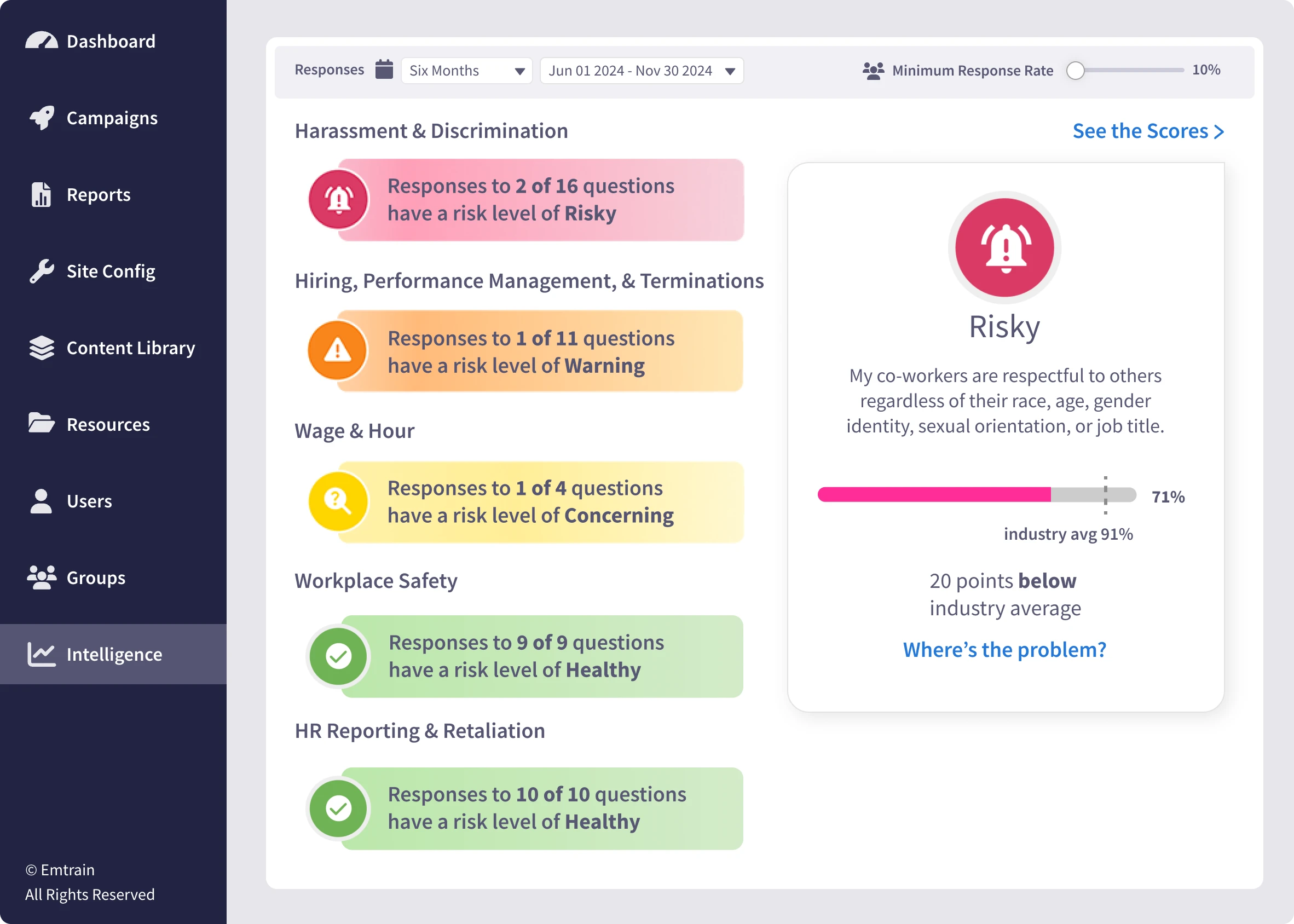Home » Concepts » Discrimination & Harassment » Workplace Color Spectrum
The Workplace Color Spectrum® is a behavior-rating tool designed to help individuals and teams communicate more effectively, reduce emotional responses, and address workplace behaviors constructively. By categorizing conduct along a shared spectrum—ranging from positive (Green) to harmful (Red)—it provides a structured framework to address and prevent conflicts while fostering a culture of respect and collaboration. Curious to how your organization stands? Try it out and take our Workplace Culture Quiz.
Emtrain’s harassment training course is engaging, interactive, and designed to spot and reduce EEO risk.

The Workplace Color Spectrum® was developed exclusively by Emtrain to address the growing need for organizations to navigate complex interpersonal dynamics in diverse and high-pressure environments. With workplace cultures becoming more multifaceted, behaviors that may seem acceptable to some can cause discomfort or misunderstandings for others. Traditional approaches to addressing such behaviors often relied on binary classifications—harassment or not—which left little room for nuanced responses. The Workplace Color Spectrum® emerged as a solution, introducing a gradation-based system that recognizes the spectrum of workplace conduct and promotes proactive intervention.
Using this spectrum, employees and leaders can rate and address behaviors with non-confrontational feedback, reducing misunderstandings and promoting accountability.
A team brainstorming session is in full swing. Each member listens attentively, builds on others’ ideas, and acknowledges diverse viewpoints. By staying socially aware and respectful, the team ensures a productive environment where everyone feels valued and can bring their best selves to work. This is an example of Green behavior: fostering collaboration and mutual respect.
During a team meeting, a colleague repeatedly speaks over others without realizing the impact. Their reactive behavior causes minor disruptions and frustration. Another team member addresses it politely, explaining how it affects the flow of the discussion. By being open to feedback, the colleague recognizes their Yellow behavior and adjusts, creating a smoother team dynamic. This is how moments of reactivity can be constructively corrected.
At lunch, a team member makes a joke based on age stereotypes, unintentionally targeting a colleague’s legally protected characteristic. Another team member intervenes, explaining the potential harm and emphasizing the importance of respect in workplace interactions. Orange behavior, even when unintended, can contribute to a disrespectful environment if not addressed. This example highlights the importance of fostering conscious communication.
A manager repeatedly criticizes and mocks an employee’s abilities in front of colleagues, creating an atmosphere of fear and humiliation. This persistent and frequent behavior exemplifies Red conduct, which is toxic and illegal. HR steps in, using the Workplace Color Spectrum framework, to intervene and address the situation effectively. This underscores the necessity of tackling pervasive, harmful behaviors to protect workplace culture.
These scenarios showcase how the Workplace Color Spectrum helps identify and address behaviors across the spectrum. But where does your workplace stand? Are you fostering a respectful, inclusive environment, or are there behaviors that might need attention?
Take the Workplace Culture Quiz on our Workplace Color Spectrum Landing Page to assess your workplace and learn how you can build a culture of respect and collaboration.
Research indicates that such tools can lead to improvements in employee relations and overall workplace culture. For instance:
While these insights are supported by various studies on workplace behavior and conflict management, it’s important to note that specific outcomes can vary based on factors such as organizational culture, the effectiveness of tool implementation, and employee engagement levels.
Learn how to identify and address blindspots that may lead to disrespectful behaviors using the Workplace Color Spectrum® framework.
Explores how the Workplace Color Spectrum® can help organizations build more inclusive and empathetic cultures.
Tailored to address workplace culture challenges using the Workplace Color Spectrum, emphasizing respect and proactive communication.
Provides practical steps for HR professionals to categorize and address workplace behaviors using the Workplace Color Spectrum®.
An engaging video demonstrating what the Workplace Color Spectrum® is and how it categorizes workplace conduct to help prevent misunderstandings.